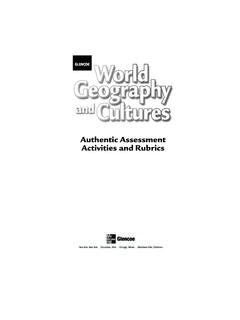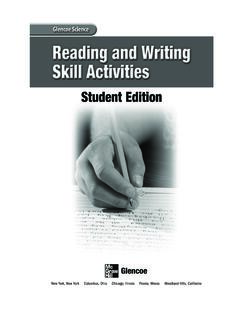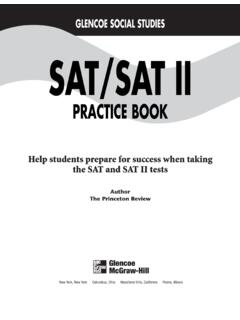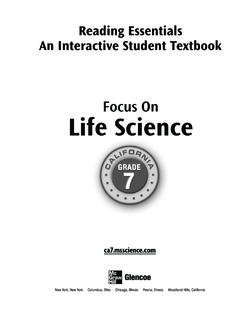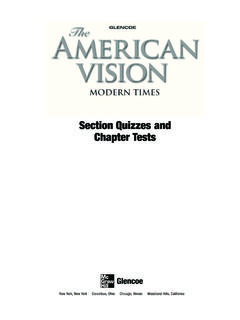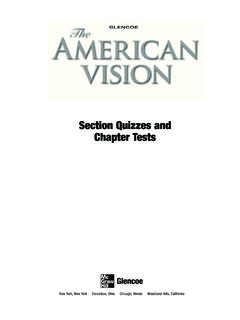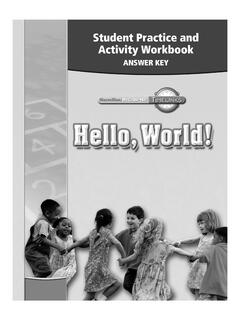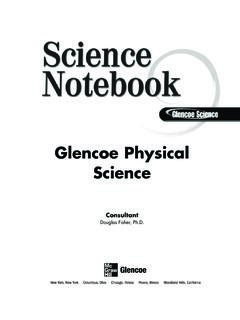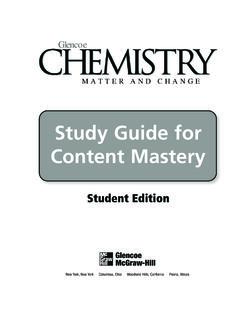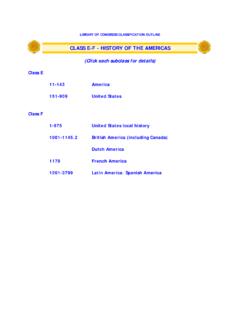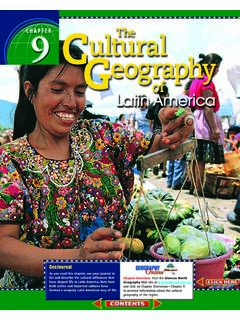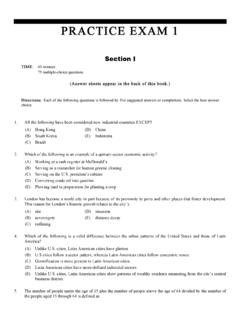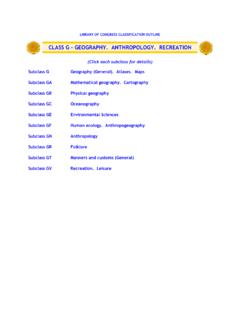Transcription of Reading Essentials and Study Guide
1 Reading Essentials and Study GuideStudent WorkbookTo the StudentGlencoe world History: Modern Times Reading Essentials and Study Guideis designed tohelp you use recognized Reading strategies to improve your Reading -for-information each section of the student textbook, you are alerted to key terms and are asked to drawfrom prior knowledge, organize your thoughts with a graphic organizer, and then follow aprocess to read and understand the text. The Reading Essentials and Study Guidewas prepared to help you get more from your textbook by Reading with a this Study tool will also help you learn the California History Social ScienceStandards for world History, Culture, and geography : The Modern world .
2 The standardsthat apply to a given section are listed on the first page of that by The McGraw-Hill Companies, Inc. All rights reserved. Permission is granted toreproduce the material contained herein on the condition that such materials be reproduced onlyfor classroom use; be provided to students, teachers, and families without charge; and be usedsolely in conjunction with the Glencoe world History: Modern Timesprogram. Any other reproduction, for sale or other use, is expressly all inquiries to:Glencoe/McGraw-Hill8787 Orion PlaceColumbus, OH 43240-4027 ISBN 0-07-872688-3 Printed in the United States of 2 3 4 5 6 7 8 9 10 047 10 09 08 07 06 05 Table of ContentsCalifornia History-Social Science Content Standards for world History, Culture, and geography : The Modern WorldChapter 1: The Legacy of the Ancient WorldSection 1: The First 2: The Civilizations of the 3: Rome and the Rise of 4: New Patterns of 2: Revolution and Enlightenment Section 1: The Glorious 2.
3 The 3: The American 3: The French Revolution and NapoleonSection 1: The French Revolution 2: Radical Revolution and 3: The Age of 4: Industrialization and NationalismSection 1: The Industrial 2: Reaction and 3: National Unification and the National 4: Culture: Romanticism and 5: Mass Society and DemocracySection 1: The Growth of Industrial 2: The Emergence of Mass 3: The National State and 4: Toward the Modern 6: The Height of ImperialismSection 1: Colonial Rule in Southeast 2: Empire Building in 3: British Rule in 4: Nation Building in Latin 7: East Asia Under ChallengeSection 1: The Decline of the Qing 2: Revolution in 3: Rise of Modern 8: War and RevolutionSection 1: The Road to world War 2: The 3: The Russian 4: End of the 9: The West Between the WarsSection 1: The Futile Search for 2: The Rise of Dictatorial 3: Hitler and Nazi 4: Cultural and Intellectual 10: Nationalism Around the WorldSection 1: Nationalism in the Middle 2: Nationalism in Africa and 3: Revolutionary Chaos in 4: Nationalism in Latin 11: world War IISection 1.
4 Paths to 2: The Course of world War 3: The New Order and the 4: The Home Front and the Aftermath of 12: Cold War and Postwar ChangesSection 1: Development of the Cold 2: The Soviet Union and Eastern 3: Western Europe and North 13: The Contemporary Western WorldSection 1: Decline of the Soviet 2: Eastern 3: Europe and the United 4: Western Society and 14: Latin AmericaSection 1: General Trends in Latin 2: Mexico, Cuba, and Central 3: The Nations of South 15: Africa and the Middle EastSection 1: Independence in 2: Conflict in the Middle 3: The Challenge of 16: Asia and the PacificSection 1: Communist 2: Independent States in South and Southeast 3: Japan and the 17: Challenges and Hopes for the FutureSection 1: The Challenges of Our 2: Global Science StandardsThe California Grade 10 Content Standards tell you what you need tolearn and be able to do as you complete your course in world History,Culture, and geography : The Modern world .
5 The course is designed tocover important events that have shaped the modern world , from thelate 1700s to the present. Reading through these standards with a familymember will help you understand the goals for your course and helpyou to achieve them. GRADE TENW orld History, Culture, and geography : The Modern Students relate the moral and ethical principles in ancient Greekand Roman philosophy, in Judaism, and in Christianity to thedevelopment of Western political Analyze the similarities and differences in Judeo-Christian andGreco-Roman views of law, reason and faith, and duties of the Trace the development of the Western political ideas of the rule oflaw and the illegitimacy of tyranny.
6 Drawing from the Selections fromPlato s Republicand Aristotle s Consider the influence of the Constitution on political systemsin the contemporary Students compare and contrast the Glorious Revolution ofEngland, the American Revolution, and the French Revolution andtheir enduring effects worldwide on the political expectations for self-government and individual liberty. Compare the major ideas of philosophers and their effects on the democratic revolutions in England, the United States, France, and Latin America ( , biographies of John Locke, Charles-LouisMontesquieu, Jean-Jacques Rousseau, Simon Bolivar, Thomas Jefferson,James Madison).
7 List the principles of the Magna Carta, the English Bill of Rights(1689), the American Declaration of Independence (1776), the FrenchDeclaration of the Rights of Man and the Citizen (1789), and the Billof Rights (1791). Understand the unique character of the American Revolution, itsspread to other parts of the world , and its continuing significance to Explain how the ideology of the French Revolution lead France todevelop from constitutional monarch to democratic despotism to theNapoleonic Discuss how nationalism spread across Europe with Napoleon butwas repressed for a generation under the Congress of Vienna and theConcert of Europe until the Revolution of Students analyze the effects of the Industrial Revolution inEngland, France, Germany, Japan.
8 And the United Analyze why England was the first country to Examine how scientific and technological changes and new formsof energy brought about massive social, economic, and cultural change( , the inventions and discoveries of James Watt, Eli Whitney, HenryBessemer, Louis Pasteur, Thomas Edison). Describe the growth of population, rural to urban migration, andgrowth of cities associated with the Industrial Trace the evolution of work and labor, including the demise of theslave trade and effects of immigration, mining and manufacturing,division of labor, and the union Understand the connections among natural resources,entrepreneurship, labor, and capital in an industrial Analyze the emergence of capitalism as a dominant economicpattern and the responses to it, including Utopianism, Social Democracy,Socialism.
9 And Describe the emergence of Romanticism in art and literature ( , the poetry of William Blake and William Wordsworth), socialcriticism ( , the novels of Charles Dickens), and the move away from Classicism in Students analyze patterns of global change in the era of NewImperialism in at least two of the following regions or countries:Africa, Southeast Asia, China, India, Latin America and Describe the rise of industrial economies and their link toimperialism and colonialism ( , the role played by national securityand strategic advantage; moral issues raised by search for nationalhegemony, Social Darwinism, and the missionary impulse; material issues such as land, resources, and technology).
10 Discuss the locations of the colonial rule of such nations asEngland, France, Germany, Italy, Japan, the Netherlands, Russia, Spain,Portugal, and the United Explain imperialism from the perspective of the colonizers and thecolonized and the varied immediate and long-term responses by thepeople under colonial Describe the independence struggles of the colonized regions ofthe world , including the role of leaders, such as Sun Yat-sen in China, andthe role of ideology and Students analyze the causes and course of the First world Analyze the arguments for entering into war presented by leadersfrom all sides of the Great War and the role of political and economicrivalries, ethnic and ideological conflicts, domestic discontent anddisorder, and propaganda and nationalism in mobilizing citizenpopulation in support of total war.
